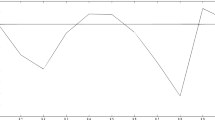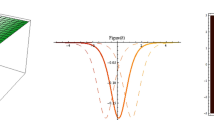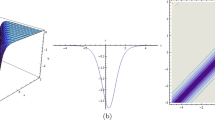Abstract
In this paper, we study the mathematical model about variable frequency water supply system in the process of applying glue to particleboard. Based on the original linear ordinary differential model, the effects of time delay and the nonlinear factor are considered. Then, we obtain the delayed nonlinear differential equation associated with variable frequency water supply system. Further, we consider the existence and stability of the equilibria and the existence of several types of bifurcations in this functional differential equation. Next, we derive the normal forms of Hopf bifurcation and Bogdanov–Takens bifurcation by using the multiple time scales method and the center manifold reduction method, respectively, and analyze the classifications of local dynamics. Finally, by using Matlab software, we obtain numerical simulations with estimated values of parameters and show the existence of stable equilibrium, stable periodic-1, periodic-2, and periodic-4 solutions, and a complex chaotic attractor from a sequence of period-doubling bifurcations.










Similar content being viewed by others
References
Nayfeh, A.H.: Introduction to Perturbation Techniques. Wiley, New York (1981)
Wiggins, S.: Introduction to Applied Nonlinear Dynamical Systems and Chaos. Springer, New York (1990)
Jiang, W., Yuan, Y.: Bogdanov–Takens singularity in Van der Pol’s oscillator with delayed feedback. Phys. D 227, 149–161 (2007)
Guo, S., Chen, Y., Wu, J.: Two-parameter bifurcations in a network of two neurons with multiple delays. J. Differ. Equ. 244, 444–486 (2008)
Tehrani, N.F., Razvan, M.: Bifurcation structure of two coupled FHN neurons with delay. Math. Biosci. 270, 41–56 (2015)
Verdugo, A.: Mathematical analysis of a biochemical oscillator with delay. J. Comput. Appl. Math. 291, 66–75 (2016)
Nayfeh, A.H.: Order reduction of retarded nonlinear systems—the method of multiple scales versus center-manifold reduction. Nonlinear Dyn. 51, 483–500 (2008)
Das, S.L., Chatterjee, A.: Multiple scales without center manifold reductions for delay differential equations near Hopf bifurcations. Nonlinear Dyn. 30, 323–335 (2002)
Saeed, N.A., El-Ganaini, W.A.: Time-delayed control to suppress the nonlinear vibrations of a horizontally suspended Jeffcott-rotor system. Appl. Math. Model. 44, 523–539 (2017)
Faria, T., Magalhães, L.T.: Normal form for retarded functional differential equations with parameters and applications to Hopf bifurcation. J. Differ. Equ. 122, 181–200 (1995)
Faria, T., Magalhães, L.T.: Normal form for retarded functional differential equations and applications to Bogdanov–Takens singularity. J. Differ. Equ. 122, 201–224 (1995)
Correa, D.P.F., Bueno, A.M., Piqueira, J.R.C.: Stability of small-amplitude periodic solutions near Hopf bifurcations in time-delayed fully-connected PLL networks. Commun. Nonlinear Sci. Numer. Simulat. 45, 66–74 (2017)
Ma, S., Lu, Q., Feng, Z.: Double Hopf bifurcation for van der Pol–Duffing oscillator with parametric delay feedback control. J. Math. Anal. Appl. 338, 993–1007 (2008)
Campbell, S.A., Yuan, Y.: Zero singularities of codimension two and three in delay differential equations. Nonlinearity 21, 2671–2691 (2008)
Jiang, J., Song, Y.: Delay-induced Bogdanov–Takens bifurcation in a Leslie–Gower predator–prey model with nonmonotonic functional response. Commun. Nonlinear Sci. Numer. Simulat. 12, 2454–2465 (2014)
Monica, C., Pitchaimani, M.: Analysis of stability and Hopf bifurcation for HIV-1 dynamics with PI and three intracellular delays. Nonlinear Anal. Real World Appl. 466, 102–116 (2015)
Wang, H., Jiang, W., Ding, Y.: Bifurcation phenomena and control analysis in class-B laser system with delayed feedback. Nonlinear Dyn. 79, 2421–2438 (2015)
Riad, D., Hattaf, K., Yousfia, N.: Dynamics of a delayed business cycle model with general investment function. Chaos Solitons Fract. 85, 110–119 (2016)
Xu, Y., Liu, Q., Guo, G., Xu, C., Liu, D.: Dynamical responses of airfoil models with harmonic excitation under uncertain disturbance. Nonlinear Dyn. (2017). doi:10.1007/s11071-017-3536-8
Li, Y., Xu, Y., Kurths, J., Yue, X.: Lévy-noise-induced transport in a rough triple-well potential. Phys. Rev. E 94, 042222 (2016)
Xu, Y., Li, Y., Liu, D., Jia, W., Huang, H.: Responses of Duffing oscillator with fractional damping and random phase. Nonlinear Dyn. 74, 745–753 (2013)
Xu, Y., Li, H., Wang, H., Jia, W., Yue, X., Kurths, J.: The estimates of the mean first exit time of a bi-stable system excited by Poisson white noise. J. Appl. Mech. (2017). doi:10.1115/1.4037158
Xu, Y., Li, Y., Liu, D.: A method to stochastic dynamical systems with strong nonlinearity and fractional damping. Nonlinear Dyn. 83, 2311–2321 (2016)
Yu, P., Ding, Y., Jiang, W.: Equivalence of the MTS method and CMR method for differential equations associated with semisimple singularity. Int. J. Bifurc. Chaos 24(1), 1450003 (2014)
Evans, P.D., Morrison, O., Senden, T.J., et al.: Visualization and numerical analysis of adhesive distribution in particleboard using X-ray micro-computed tomography. Int. J. Adhes. Adhes. 30, 754–762 (2010)
Hundhausen, U., Militz, H., Mai, C.: Use of alkyl ketene dimer (AKD) for surface modification of particleboard chips. Eur. J. Wood Wood Prod. 67(1), 37–45 (2009)
Zhu, L., Liu, D., Cao, J.: Technological characteristic analysis and main parameters control model of glue system for plane fiber artificial board. Indus. Control Appl. 32(11), 15–23 (2013)
Kuznetsov, Y.A.: Elements of Applied Bifurcation Theory, 3rd edn. Springer, New York (2004)
Acknowledgements
The author wishes to express her special gratitude to the editors and the reviewers for the helpful comments given for this paper. This work was supported by the National Nature Science Foundation of China (No. 11501091) and the Fundamental Research Funds for the Central Universities (No. 2572017CB2).
Author information
Authors and Affiliations
Corresponding author
Appendices
Appendix A
When \(\tau =\tau _k^{(j)},k=1,2;~j=0,1,2,\ldots \), where \(\tau _k^{(j)}\) is given by (9), the characteristic equation (6) has one pair of pure imaginary roots \(\lambda ={\pm }i\beta _k\). We treat the time delay \(\tau \) as the bifurcation parameter. Suppose system (5) undergoes a Hopf bifurcation from the trivial equilibrium at the critical point: \(\tau =\tau _c\). Next, we use the multiple time scales method to derive the normal form of system (5) associated with Hopf bifurcation. Further, by the MTS, the solution of (5) is assumed to take the form:
where \(\omega _j=\omega _j(T_0,T_1,T_2,\ldots ),~j=1,2,3,\ldots \) with \(T_k=\epsilon ^kt,~k=0,1,2,\ldots \). The derivative with respect to t is now transformed into
where the differential operator \(\mathrm {D}_i=\frac{\partial }{\partial T_i},~i=0,1,2,\ldots .\)
We take perturbation as \(\tau =\tau _c+\epsilon \tau _\epsilon \) in (5), where \(\tau _\epsilon \) is called a detuning parameter [7]. To deal with the delayed terms, we expand \(\omega _j(T_0-\tau _c-\epsilon \tau _\epsilon ,T_1-\epsilon (\tau _c+\epsilon \tau _\epsilon ),T_2-\epsilon ^2(\tau _c+\epsilon \tau _\epsilon ),\cdots )\) at \(\omega _j(T_0-\tau _c,T_1,T_2,\ldots )\) for \(j=1,2,3,\ldots \), then
where \(\omega _{j\tau _c}=\omega _j(T_0-\tau _c,T_1,T_2,\ldots ),~j=1,2,3,\ldots \).
Then, substituting the solutions with the multiple scales (17) and (18) into (5) and balancing the coefficients of \(\epsilon ^n~(n=1,2,3,\ldots )\) yields a set of ordered linear differential equations.
First, for the \(\epsilon ^1-\)order terms, we have
where \(A_k=-\frac{D+pK_0+2pK_mE_k}{J}\) and \(B_k=\frac{a+2bE_k}{J}\). Since \({\pm }i\beta _k\) is the eigenvalues of the characteristic equation (6), the solution of (19) can be expressed in the form of
where \(G=G(T_1,T_2,\ldots )\) and \(\bar{G}=\bar{G}(T_1,T_2,\ldots )\).
Next, for the \(\epsilon ^2-\)order terms, we obtain
Substituting solution (20) into (21) and simplifying, we obtain the following equation:
where c.c. stands for the complex conjugate of the preceding terms.
Non-homogeneous equation (22) has a solution if and only if the so-called solvability condition is satisfied [1]. That is, the right-hand side of non-homogeneous equation (22) is orthogonal to every solution of the adjoint homogeneous problem. As a matter of fact, finding the solvability conditions is equivalent to finding the conditions resulted from eliminating the secular terms. To avoid occurrence of secular terms in the solution of (22), the coefficients of \(\mathrm {e}^{i\beta _k T_0}\) in (22) must be set zero. Then, \(\frac{\partial G}{\partial T_1}\) is solved to yield
where \(f_k=-\frac{B_ki\beta _k\mathrm {e}^{-i\beta _k \tau _c}}{1+B_k\tau _c\mathrm {e}^{-i\beta _k \tau _c}}\).
Then, Eq. (22) is reduced to
thus, the particular solution of \(\omega _2(t)\) is obtained from the resulting equation of (24) as
where
with \(h_0^{(k)}=-\frac{2(b-pK_m)}{J(A_k+B_k)}\), \(h_1^{(k)}=\frac{b\mathrm {e}^{-2i\beta _k \tau _c}-pK_m}{J(2i\beta _k -A_k-B_k\mathrm {e}^{-2i\beta _k \tau _c})}\), \(k=1,2\).
Further, for the \(\epsilon ^3-\)order terms, we similarly obtain
Substituting the solutions (23) and (25) into (26) and letting the coefficients of the terms which may generate secular terms in the solution equal zero, yields the derivatives \(\frac{\partial G}{\partial T_2}\) expressed in terms of G,
where
with
The above procedure can in principle continue indefinitely (to any high order). Finally, the equation for \(\frac{\partial G}{\partial T_0}\) is given by
Let \(\epsilon \rightarrow 1/\epsilon \), and by (23) and (27), we derive the following normal form
Note that \(\tau ^2_\epsilon G\) is small enough for small unfolding parameter \(\tau _\epsilon \), and we can omit term \(g_0^{(k)}\tau ^2_\epsilon G\) for local normal form. Moreover, the normal forms derived by using the MTS and CMR methods are identical, and we also denote \(\frac{\partial G}{\partial T_0}\) as \(\dot{G}\) for consistency [24] and thus yield the following normal form up to the third order:
where \(f_k\) and \(g_k\) are given by (23) and (27), respectively.
Appendix B
In this section, we consider the system (13) and derive the normal form of Bogdanov–Takens bifurcation. We can check that the Bogdanov–Takens bifurcation occurs when \(A+B=0\) and \(B\tau +1=0\) in system (13). Thus, we introduce two bifurcation parameters as \(\tau =\tau _c+\mu _1\) and \(a=a_c+\mu _2\) and choose
where \(A=-\frac{1}{J}(D+pK_0+2pK_mE_0)\) and \(B=\frac{1}{J}(a_c+2bE_0)\) with \(E_0=\frac{-a+D+pK_0}{2(b-pK_m)}\).
Then, the linearized equation of (13) at the trivial equilibrium is
where \(L_0\phi =\int _{-1}^{0}d\eta (\theta )\phi (\theta ),~\phi \in C = \mathrm {C}([-1,0],~R^{1})\), and the bilinear form on \(C^*\times \mathrm {C}\) (\(*\) stands for adjoint) is
in which \(\phi \in C\), \(\psi \in C^*\). Then, the phase space C is decomposed by \(\varLambda =\{0\}\) as \(C = P\oplus Q\), where \(Q=\{\varphi \in C:~(\psi ,\varphi )=0, \mathrm {for~ all}~\psi \in P^*\)}, and the bases for P and its adjoint \(P^*\) are given respectively by
and
We use the bifurcation parameters given by \(\tau =\tau _c+\mu _1\) and \(a=a_c+\mu _2\) in (13), where \(\mu _1\) and \(\mu _2\) are perturbation parameters and denote \(\mu =(\mu _1,\mu _2)\). Then, (13) can be written as
where
and
We now consider the enlarged phase space \(\mathrm {BC}\) of functions from \([-1,0]\) to \(R^2\), which are continuous on \([-1,0)\) with a possible jump discontinuity at zero. This space can be identified as \(C\times R^2\). Thus, its elements can be written in the form \(\psi =\varphi +X_0c\), where \(\varphi \in C\), \(c\in R^2\) and \(X_0\) is a \(2\times 2\) matrix-valued function, defined by \(X_0(\theta )=0\) for \(\theta \in [-1,0)\) and \(X_0(0)=i\). In the \(\mathrm {BC}\), (29) becomes an abstract ODE,
where \(u\in C\), and \(\mathcal {A}\) is defined by
and
By the continuous projection \(\pi :~\mathrm {BC}\mapsto P\), \(\pi (\varphi +X_0c)=\varPhi [(\varPsi ,\varphi )+\varPsi (0)c]\), we can decompose the enlarged phase space by \(\varLambda =\{0\}\) as \(\mathrm {BC}= P\oplus \mathrm {Ker} \pi \), where \(\mathrm {Ker} \pi =\{\varphi +X_0c:~\pi (\varphi +X_0c)=0\}\), denoting the Kernel under the projection \(\pi \). Let \(x=(x_1,x_2)^{\mathrm {T}}\), \(v_{t}\in Q^1 :=Q\cap \mathrm {C}^{1}\subset \mathrm {Ker} \pi \), and \(\mathcal {A}_{Q^1}\) the restriction of \(\mathcal {A}\) as an operator from \(Q^1\) to the Banach space \(\mathrm {Ker} \pi \). Further, denote \(u_{t}=\varPhi x+v_{t}\). Then, Eq. (29) is decomposed as
where
Next, let \(M_2^{1}\) denote the operator defined in \(V_2^4(R^2 \times \mathrm {Ker} \pi )\), with
where \(V_2^4(R^2)\) represents the linear space of the second-order homogeneous polynomials in four variables \((x_1,x_2,\mu _1,\mu _2)\) with coefficients in \(R^2\). Then, it is easy to verify that one may choose the decomposition \( V_2^4(R^2)=\mathrm {Im}(M_2^1)\oplus \mathrm {Im}(M_2^1)^c\). The base of \(V_2^4(R^2\times \mathrm {Ker} \pi )\) is composed by the following 20 elements \((i=1,2)\):
and images of there elements under \(M_2^1\) are
Therefore, a basis of \(\mathrm {Im}(M_2^1)^c\) can be taken as the set composed by the elements
Consequently, the normal form of (13) on the center manifold associated with the origin equilibrium near \((\mu _1,\mu _2)=(0,0)\) has the form
where \(g_2^1\) is the function giving the quadratic terms in \((x_1,x_2,\mu _1,\mu _2)\) for \(v_{t}=0\) and is determined by \(g_2^1(x,0,\mu _1,\mu _2)=\mathrm {Proj}_{(\mathrm {Im}(M_2^1))^c}\times f_2^1(x,0,\mu _1,\mu _2)\), where \(f_2^1(x,0,\mu _1,\mu _2)\) is the function giving the quadratic terms in \((x,\mu _1,\mu _2)\) for \(v_{t}=0\) defined by the first equation of (31). Thus, the normal form, truncated at the quadratic-order terms, is given by
where \(\lambda _1=\frac{2\tau _c}{J}\mu _2\), \(\lambda _2=-2B\mu _1-\frac{4\tau _c}{3J}\mu _2\), \(d_1=\frac{2\tau _c(b-pK_m)}{J}\), \(d_2=\frac{4\tau _c(b-pK_m)}{3J}-\frac{4b\tau _c}{J}\).
Rights and permissions
About this article
Cite this article
Ding, Y. Dynamic analysis of nonlinear variable frequency water supply system with time delay. Nonlinear Dyn 90, 561–574 (2017). https://doi.org/10.1007/s11071-017-3681-0
Received:
Accepted:
Published:
Issue Date:
DOI: https://doi.org/10.1007/s11071-017-3681-0




